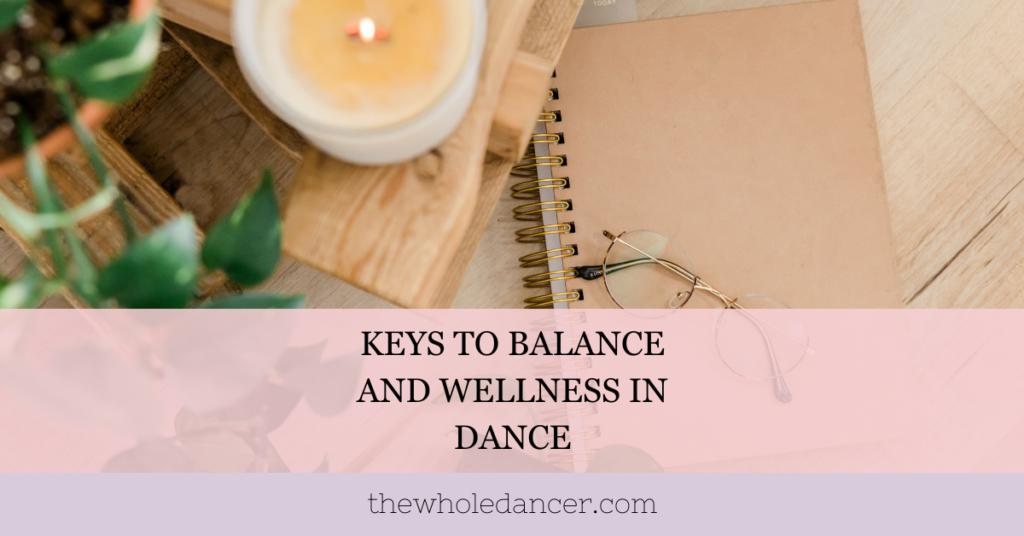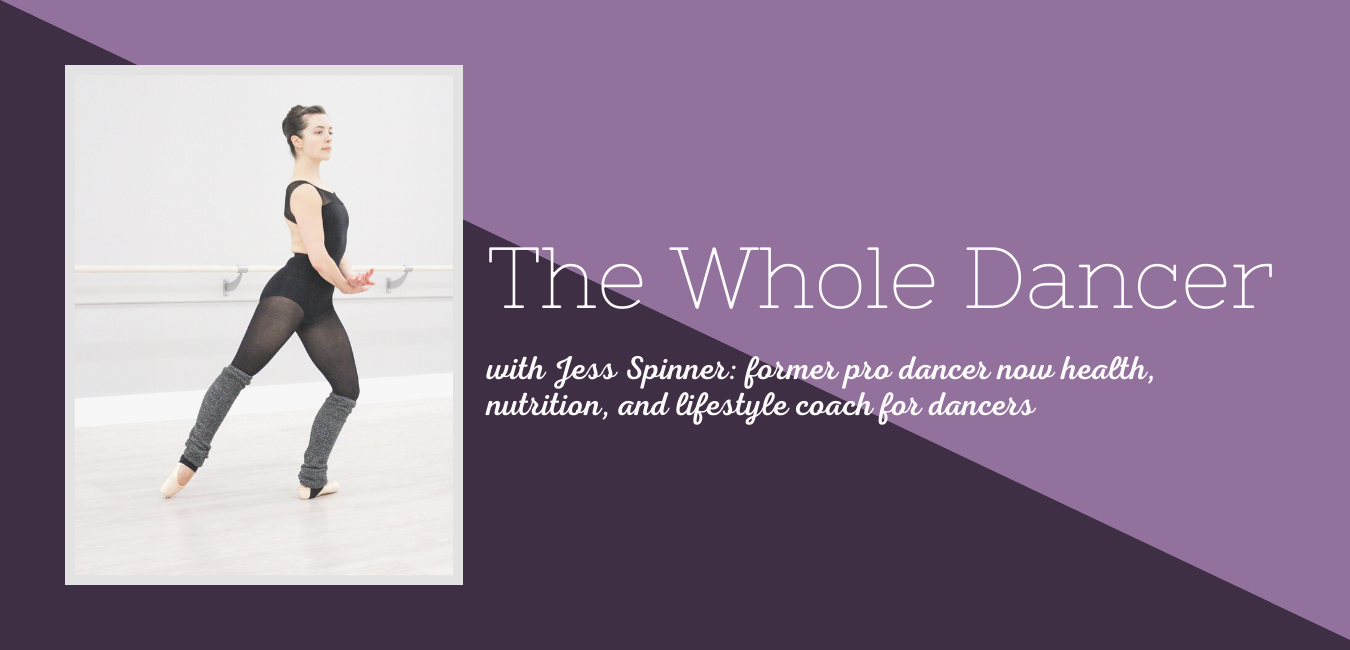The competitive nature of dance is undeniable. Whether you’re a competitive dancer or you’re vying for your next professional job, you’re bound to face competition, and with that comes stress. It’s essential to prioritize balance and wellness in dance to find success and do your best dancing.
In order to combat the stress of your dance persuits, you need to have practices in place. To make practical shifts, consider both your mindset and practices in the areas of food, body image, progress in dance, and lifestyle. These pieces are all essential to perform at your best. They’re key components to dancer wellness.
It might be easier to tell yourself that to perform your best, all that matters is the work you put in when you’re in the studio.
The truth is that when you take care of yourself outside the studio and prioritize your health — mentally and physically — you will be more resilient in dance.
The mindset is how you think about each of these areas. Are you prioritizing them? Do you see the importance in eating well, seeing yourself in a positive light, being ambitious and realistic in your progress, and having a balance in lifestyle?
An essential element of the mindset for success truly is belief in yourself.
Sports psychologist Stan Beecham says, “If you think of people who consistently win, you would say, ‘Well, they win all the time because they want to win, right? They want it bad enough.’ The reality is that’s not true at all. It’s that people that win and succeed at a high level, they don’t actually think about winning. They simply believe they’re going to do well.”

Let’s break these pieces down…
Food: The Mindset
The food you put into your mouth is going to impact your performance. There’s honestly no question that the fuel you choose can either harm or enhance how you dance. If you’re fueling a sports car, are you going to fill it with regular or premium gas? Your body should be treated the same way.
Food is your fuel and it should also be enjoyed. You need to create a healthy relationship with food and not see any foods as “bad” or “off limits.” When you make some foods “bad” and others “good,” you usually end up feeling guilty when you eat the “bad” foods.
You also can fall into the trap of thinking the good food is all tasteless and bland. Healthy food needs to be delicious. When you view all the food you eat as food, fuel, and something you should enjoy, you’ll create a positive approach to food.
Food: The Practice
When you create a food plan it’s important to think about what your day looks like. When do you have breaks? How many hours will you be in class, rehearsals, cross-training?
Then, think about how you’ll get lots of vitamins and minerals; eat a rainbow of colorful foods. Make sure you’re consuming greens, fruits, colorful vegetables — disease-fighting, health-promoting foods.
Finally, ask yourself what balance looks like for you. Avoiding the foods that provide pure joy: cake, cookies, desserts will not help you feel balanced in your approach to food. How will you incorporate those foods so you can enjoy them without guilt?
Body: The Mindset
As a dancer, when you look at your body in the mirror, the typical response is to pick out what’s wrong. How can you improve? How can you make your body better, implying that it’s not all that it could or should be.
To be a confident dancer, you need to support and love your body as it is. Your body shape is pretty set. Yes, you can make shifts, but some things are predetermined. When you get to a place of self-acceptance, you’re going to be a more confident person and dancer.
Try to view your dancing without tearing your physical body apart. Just because you have bigger thighs or calves or arms or a butt doesn’t mean you can’t dance beautifully and to your full potential. When you focus on your capabilities instead of your body parts, you’ll progress at a quicker rate and increase your confidence.
Body: The Practice
Positive self-talk and a positive body image is all about practice. Whatever messages you reinforce for yourself on a consistent basis are the ones you’ll start to believe. Look in the mirror and remind yourself that you are enough. You have unique gifts. You can succeed in dance.
Care for your body outside of the studio with massage, foam rolling, epsom salt baths, supportive cross-training and health and nutrition support.
Progress: The Mindset
It’s important to see your progression in dance as a journey. There will be peaks and valleys. There will be times when things come more easily and other times when there’s a greater challenge ahead of you.
It’s said that successful people are not successful because things come more easily to them but because of how they respond to setbacks or perceived failures.
Progress: The Practice
Do you write goals and keep notes on corrections, technique, and choreography? Have you created a vision for your life and dancing and thought about where you’d like it all to take you?
When you dream and envision a bigger outcome for yourself, you’re more likely to reach it. Rather than making your goal to achieve some level of perfection, think about goals that prioritize consistent progress.
Lifestyle: The Mindset
The way you craft your life outside of the studio will have a direct impact on your ability to perform in the studio. If your life outside is chaotic and there’s no planning or structure, you’ll likely lack the focus and drive needed to succeed in dance.
It’s beneficial to have a life outside of dance in order to have relationships and experiences that can feed your dancing. With a greater breadth and depth, you’ll bring so much more to the roles and choreography you perform.
Lifestyle: The Practice
Support your dancing with what you do outside of dance, but don’t forget to give yourself moments fully away from dance. How can you connect to your soul? How can you find peace and calm in your home environment or the outdoors?
From a 2018 collaboration with So You Think You Can Dance!!
Every year when a new season of So You Think You Can Dance amps up, we’re given a new group of dancers to relate to, empathize with, and root for. This season, SYTYCD has put a focus on Dancer Wellness, which I’m thrilled about! At The Whole Dancer, the health and wellness of dancers is a fundamental part of my mission.
I’m so inspired that SYTYCD has recognized the need for more focus on the well-being of dancers, and I can’t wait to tune in this season!
Ready for a more balanced approach on your dance journey? Sign up for a complimentary coaching call and you’ll gain clear strategy to prioritize your well-being.
So You Think You Can Dance choreographer Mandy Moore shares her thoughts on “balance”:
1. How do you stay “balanced” as a dancer/what does balance mean to you?
For me, balance is about making sure that I continue to experience things outside of dance. I love to snowboard and camp to spend as much time outside in nature as possible. Every time I spend time away from dance, I love it even more when I get back in the studio. I think balance is essential in any part of life. In order to be a great dancer, you have to also be a great human.
2. How do you cross-train?
I love to hike and play sports. I have never been a big gym person, so being outdoors is important for me.
3. What’s your go-to healthy dance fuel (snacks, meals, food, etc.)?
Almonds! I love a poke bowl w/ rice, fish and veggies! Lots of water!
Photo Credit: Adam Rose/FOX
